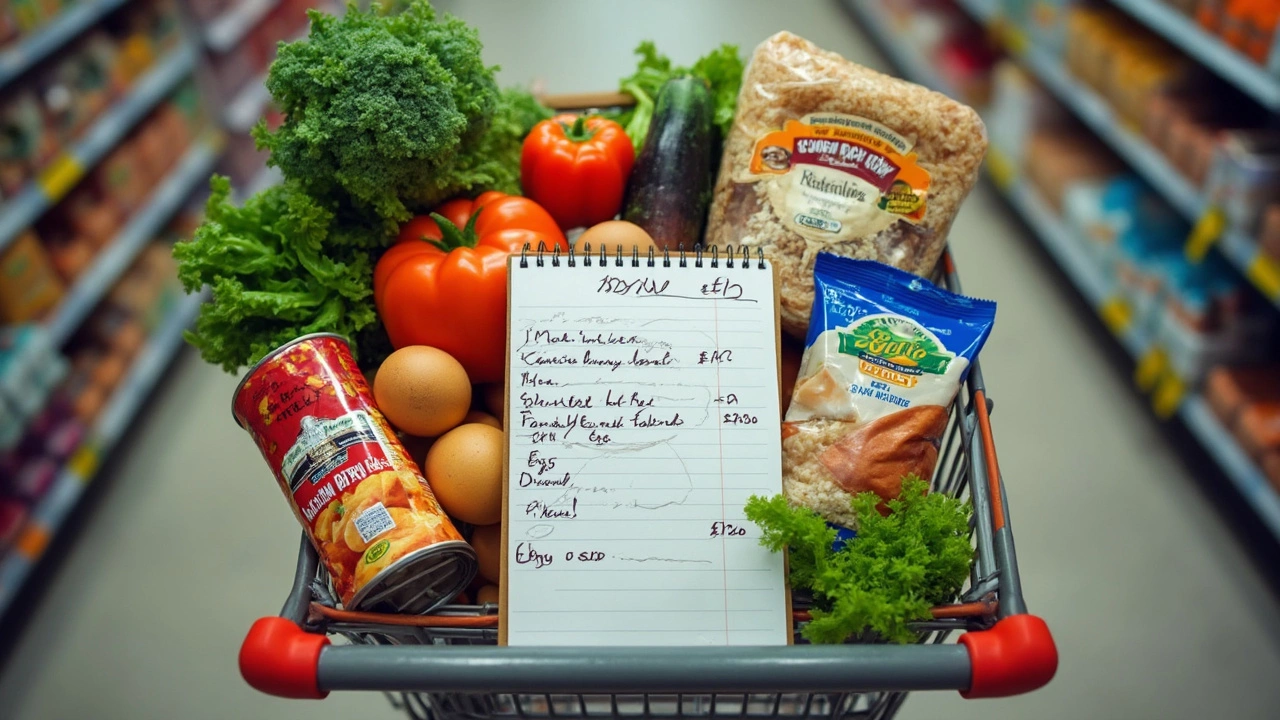Ten bucks a day for four people—it sounds impossible, right? I've been there, doing mental math in grocery store aisles, figuring out which foods fill bellies but don't empty wallets. You don't have to survive on instant noodles and bland sandwiches, though. Start with a simple fact: the cheapest calories come from whole foods, not processed stuff or convenience meals.
Oatmeal, dried beans, rice, eggs, and carrots top my list every week. These basics aren't just affordable—they're versatile and packed with nutrients. Skip fancy brands; store labels usually taste the same. The key? Build meals around core staples, then add whatever veggies or proteins are on sale. With this system, even $10 stretches further than you'd think.
Price makes you creative. Ever made chili with half the meat and extra beans? Or used frozen veggies instead of fresh to save three bucks? Small changes add up fast, and nobody even notices the swaps once dinner hits the table. That's the real trick here—trading pricey habits for smart, flavorful workarounds. Let's see how far your dollar can go.
- What $10 Really Buys: Breaking Down the Budget
- Smart Shopping and Ingredient Swaps
- Stretching Meals Without Losing Flavor
- Sample $10-a-Day Meal Plan
What $10 Really Buys: Breaking Down the Budget
If you’ve ever stood in the checkout line, sweating over whether you’ll have enough cash, you know how every dollar matters. Feeding a family of four on $10 a day means a grocery budget of $70 for the week. You can’t wing it. You’ve got to know which foods stretch farthest and give the best bang for your buck.
Think bulk. The best deals are almost always found on staple foods—stuff like rice, beans, oats, and potatoes. These fill you up, can be bought in big bags, and last a while. Proteins are the trickiest, especially with prices rising. That’s when things like eggs, canned tuna, and frozen chicken become your best bets. And for veggies? Frozen is way cheaper than fresh, plus there’s no waste from spoilage.
The simplest way to see where your cash is going is to look at real prices. Here’s what you can expect to pay at most national supermarkets in the U.S. as of early 2025:
| Item | Average Cost | Uses |
|---|---|---|
| Rice (2 lbs) | $1.80 | Base for stir-fries, soups, sides |
| Dried beans (1 lb) | $1.60 | Soups, stews, salads, chili |
| Oats (42 oz) | $3.00 | Breakfast, baking, savory oats |
| Dozen eggs | $2.20 | Scrambles, baking, sandwiches |
| Carrots (2 lbs) | $1.50 | Soups, snacks, stir-fries |
| Frozen mixed veggies (1 lb) | $1.25 | Any meal needing veggies |
| Chicken thighs (1.5 lbs, frozen) | $3.60 | Main protein for 2-3 meals |
| Bananas (2 lbs) | $1.30 | Snacks, breakfast |
You can see pretty quick where things add up. Protein is the priciest slice of the budget. That’s why most cheap family meals rely on eggs, beans, and stretching meat with veggies or grains. It’s not about living off plain rice and beans, though. The right combo can make meals satisfying and even a little fun.
- Stick to staples that do double or triple duty in different recipes throughout the week.
- Lean on whatever is on sale—even if it means pivoting on your meal plan.
- Check unit prices on store shelves to spot the real bargains instead of falling for flashy deals that aren’t actually cheap per serving.
The point is, with a focused plan and real prices in mind, $10 goes a lot further than you’d think. It’s not fancy, but it works—and you won’t go hungry.
Smart Shopping and Ingredient Swaps
If you're trying to feed four people on a tight budget, the grocery store can either save you or sink you. Shop with a plan instead of just grabbing whatever looks good. Always scan local ads for weekly deals. Some basic rules: buy in bulk, skip name brands, and never hit the store hungry. That last one isn't a myth—hungry shoppers spend up to 60% more.
Focus on whole foods that stretch. One pound of dried beans costs less than $2 and gives you about six cups cooked. Rice is cheap and filling. Canned tomatoes make anything taste better, from stew to pasta. A dozen eggs is usually under $2. Instead of fresh chicken breasts, grab a whole chicken; you get meat for several meals and bones for soup stock.
- Trade ground beef for lentils in tacos or spaghetti sauce. Even swapping out half the meat saves big money.
- Frozen veggies (like peas or mixed stir-fry blends) almost always cost less and last longer than fresh ones, with the same nutrition.
- Greek yogurt can replace mayo or sour cream in recipes, stretching a tub further across several meals.
- Use oats instead of boxed cereals. Oats fill you up and can be jazzed up with fruit, honey, or a sprinkle of cinnamon.
Bagging the right items makes all the difference in your family meal ideas arsenal. Here’s a quick comparison of some budget basics, showing just how much bang you get for your buck.
| Item | Avg. Price (2025, U.S.) | Servings per Package | Cost per Serving |
|---|---|---|---|
| Dried Pinto Beans (1 lb.) | $1.50 | 8 | $0.19 |
| White Rice (2 lbs.) | $2.00 | 20 | $0.10 |
| Eggs (1 dozen) | $2.10 | 6 meals (2 eggs each) | $0.35 |
| Frozen Mixed Veggies (16 oz.) | $1.30 | 4 | $0.33 |
| Whole Chicken (4 lbs.) | $7.00 | 8 | $0.88 |
When you swap expensive cuts, prep from scratch, and snatch up sale items, hitting that $10 mark each day isn't a pipe dream. Smart choices keep your plates—and wallets—full.

Stretching Meals Without Losing Flavor
You don’t have to sacrifice taste just because you’re sticking to cheap family meal ideas. Some of the best flavor tricks are actually the cheapest—and you probably have what you need in your pantry right now. The goal is to bulk up meals without anyone feeling like they’re missing out.
Start with portion boosters. Beans, lentils, and rice can double the size of a meal for just pennies a serving. If you’re whipping up a pot of chili, use half the usual ground beef and fill out the rest with two cans of beans and an extra handful of frozen corn. Nobody’s going to ask where the extra meat went—the flavor is still there.
Next, use seasoning smartly. Bags of dried herbs and big containers of garlic or onion powder might look pricey up front, but they’re much cheaper per serving than those tiny jars. Plus, a dash of cumin or a sprinkle of dried basil makes even plain rice taste like something special. If you have leftovers, turn them into fried rice or a soup base for the next day. That way, every bit of seasoning keeps working for you.
Here are a few ways we routinely stretch dinner at home while keeping everyone happy:
- Build “kitchen sink” soups by simmering leftover veggies, rice, and a bouillon cube. Toss in some leftover chicken or beans. Add noodles if you’ve got them.
- Turn stale bread into croutons or bread crumbs for casseroles and homemade nuggets.
- Bulk up casseroles and skillets with lentils or diced zucchini—neither changes the taste much, but both add heft.
- Buy bone-in chicken. It’s usually cheaper per pound than boneless, and the bones can be used for homemade broth. Broth adds flavor and gives you a base for a second meal.
Want to see how much difference this stuff makes? Look at this comparison:
| Ingredient | Price for 4 servings | Calories per serving |
|---|---|---|
| Beef (1 lb) | $4.70 | 250 |
| Pinto beans (2 cups cooked) | $0.80 | 440 |
| White rice (2 cups cooked) | $0.50 | 410 |
If you swap half the beef for beans and a scoop of rice, you’ve got more food and more calories, but you’ve spent about $2 less. That’s money you can use the next day to buy extra veggies or even treat the kids to fruit for dessert.
Bottom line: Stretching your meals is mostly about sneaky add-ins, smart seasoning, and using every bit of what you buy. It’s doable, and nobody at the table will complain—especially if you keep mixing things up so dinner never feels the same two nights in a row.
Sample $10-a-Day Meal Plan
If you’re actually feeding a family of four for $10 a day, you need a plan that covers breakfast, lunch, dinner, and maybe a small snack. Here’s a real breakdown you can copy or tweak. I’ve used simple staples and actual supermarket prices from national grocery chains (think Walmart, Aldi, Kroger) as of early 2025. Everything adds up to roughly a ten-dollar bill—no calculator sweat required.
| Meal | What You Get | Approx. Cost |
|---|---|---|
| Breakfast | Oatmeal (with banana & brown sugar) | $1.25 |
| Lunch | Lentil & veggie soup, toast | $2.00 |
| Dinner | Rice and beans with sautéed frozen veggies | $3.25 |
| Snacks | Carrot sticks & peanut butter | $1.00 |
| Milk or tap water with meals | $2.25 | |
| Total | $9.75 |
This meal plan is built on the strong backbone of budget meals. Oatmeal for breakfast takes less than five minutes, and a big bag from the bottom shelf will last days. Bananas and a shake of brown sugar keep it interesting for even picky kids. For lunch, lentil soup is magic: it’s cheap, filling, and you can dump in any wilted veggies you’ve got. Toast on the side, from that value loaf, gives a little crunch and more calories for growing kids.
Dinner is the core meal—classic cheap family meals style. Rice and beans are both protein powerhouses. Top that with a quick fry-up of frozen mixed veggies, and nobody’s going hungry. If the budget allows, toss in a little hot sauce or grated cheese for extra flavor. Snack on carrot sticks with a bit of peanut butter, which honestly keeps everyone from raiding the pantry after school. Water is free, but if you can stretch to some milk, that covers a lot of nutritional bases, especially for kids.
- Buy store-brand where you can—usually way cheaper, and there’s no taste difference for basics like rice, pasta, or oats.
- Don’t buy pre-sliced or single-serve anything—bulk and whole saves much more money.
- Every extra quarter counts: check weekly flyers and use rewards apps if your store offers them.
Bottom line: $10 a day keeps things simple, but you’ll still get real food and enough variety that family mealtimes don’t get boring. If you get used to these basics, you can swap things around without busting the budget—sometimes we’ll make pancakes from scratch for breakfast, or pasta with canned tomatoes for dinner if there’s a sale. Once you nail down what your family likes, the whole process gets way easier—and nobody even remembers the days when you thought $10 a day was impossible.

